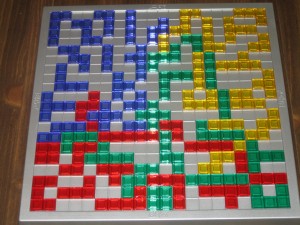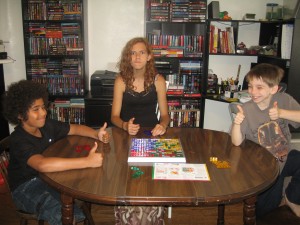I can’t count how many times I considered purchasing this game when I passed by it in the store. I was always intrigued by its general premise, but wasn’t sure how much fun placing pieces on a flat playing surface would be. Granted, I got a lot of mileage out of playing Tetris on the Game Boy, but I was skeptical that a lot of its charm would be lost in the conversion. I quickly learned however that Blokus isn’t Tetris, but something far, far better, in my opinion.
Blokus is a simple game to learn, but has a lot of depth to it, much to my surprise. Players are given a set of colored Tetris-esque pieces and in turn, place them on the board in the hopes that they can get rid of all of them before the game ends. Let’s take a quick look at the components and gameplay before heading into the review.
Components
Board – The board is a flat, 2D surface with square grooves throughout, allowing the piece blocks to fit snugly into them.
Pieces – There are numerous pieces of different sizes and shapes that each player will receive via a color set. Each colored set has the same amount of piece types in it, giving each player an equal chance to win the game.
Gameplay
The object of Blokus is to have the most points when the game ends, which is when all players have no more pieces that they can legally place. The board is fairly large, so placing all of your pieces sounds pretty easy right? It turns out, no…especially if you have four different people of varying skill playing. The kicker is that you can only place your pieces so that it is one space away diagonally from an existing piece of your color. Your pieces can’t touch horizontally or vertically and must connect via the one space diagonal rule. Depending on how the pieces play out, your available space can quickly become limited.
Players begin by placing a piece so that one of its blocks is in the corner. Taking turns, they expand inward, choosing whichever piece they wish and placing it legally on the board. After this goes on for a few turns, players will eventually run into each other and limit each other’s piece placement. Once all players have placed everything they can, they count up how many individual blocks that they haven’t placed (pieces are made up of blocks) and this becomes their negative score. Players who manage to place all of their pieces earn fifteen points, plus an extra five if the last piece they placed was the “one-block” piece. The person with the highest score (or lowest negative score if no one placed all of their pieces) wins the game.
If you are interested in the finer details, you can check out the manual here: Blokus Manual.
The Review
Blokus caught me completely by surprise. What I thought was a simple, piece placement game turned out to be an epic rollercoaster ride…one in which I wouldn’t get motion sickness from. This game is very easy to play but offers a wide range of strategic play, especially toward the middle of the game. I quickly saw how important it was to expand, lest I be trapped into a corner without the ability to get past my opponent’s pieces. Not only did I have to worry about expanding, but I also had to come up with ways to block my opponents from being able to dominate the board. When you have three other people playing, it can be a real challenge to do this. You might be able to trap yellow into a corner, but blue and green might waltz all over your available territory in the process.
Having just played and reviewed Tetris Link, I saw a lot of similarity in the pieces. They looked the same, except for that Blokus had a much wider range of differently shaped pieces. I was just as pleased with the components in Blokus as I was in Tetris Link.
The kids enjoyed Blokus, especially Devonn (11). He commented that he used to play it in his gifted classes and loved trying to figure out his next move. Having played this game a few times, I can see the educational value in introducing this game to schools. Blokus forces players to think ahead and to adapt to the current situation as it stands…something that I encourage all kids to learn and take to heart as early on in life as possible.
The other kids, Carolyn (13) and Vinnie Jr (11) loved the game as well, so much that we all played it again a second time. All three kids were constantly trying to visualize which of their available pieces should go where. I opted to try and play my five block pieces first and expand towards the center so that I could branch out and thus have more room to work. Towards the end, I was able to place most of my smaller pieces to where I’d only have a few left when the game ended. My best score, thus far, is “-11”. The other kids weren’t far behind and it was a close couple of games through and through.
I highly recommend this game for people of all ages, especially families. This is a great game for kids and would make an excellent addition to your game collection. It’s quick, it’s fun, and it’s educational. Any game with these characteristics gets an “A+” in my book.
Final Verdict: 10/10
—



